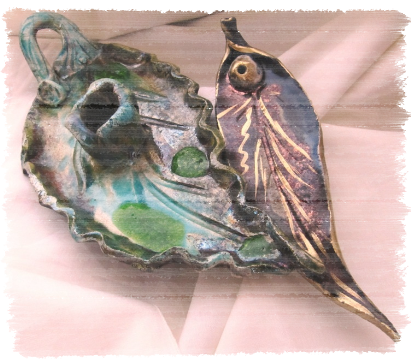Come into play
The techniques
My works > Porcelain
The Classic technique
This is the first technique I learnt from my friend Mariella, I did several pieces with, objects that filled my relatives' houses and mine. They look pretty, even if - in my today's eyes - they show a little bit na´fs.
I'm still using this technique, that I alternate with the miniature style, depending on the subjects and the results I should like to obtain.
I employ this technique expecially to reproduce landscapes or some floral patterns.
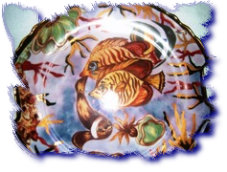
The miniature with water colours
I like this technique a lot, to paint flowers above all. I have several reasons to love it.
First of all we use water to thin colours, that is to say to work in an environment without unpleasant smells.
Besides, we can reproduce the smallest details of petals and leaves, we can high-light the micro nervatures and we can obtain a three-dimensional effect. The flower on the vase in a good example.
In the end, we can regenerate the colours so we have no waste.
This technique is the exact opposite of the classic or the american ones, as the basic colour is laid in a very light tone; after we add dark tonalities to make shadows, that - by contrast - let lights to spring up.
It is however a very detailed technique and for this reason is very long to realize: it is therefore destinated to very rich people.... in patience!

American Technique (Soft oil)
This is the technique I lately learnt. Always driven by my will to know and to experiment with new styles, I got in touch with some Masters of Brazilian school, and I brought myself into play, trying also this technique.
This way of painting is for me a sort of Trojan Horse, to learn by those Masters, who exclusively work with the american technique, further secrets, movements, colours' use, techniques, new products an so on.
The soft oil allows the colours to keep wet until firing, so you can try and try again on your piece till to obtain the results you wish; at the same time you risk to crash into the pitiless rule of "trhee times": the first brush-stroke sketches, the second one tidies, the third one ruins.
It is also necessary to have a very soft hand to gradate colours very well, without entirely removing them.
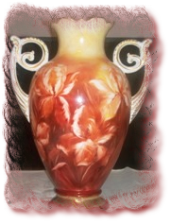
The lustres
They are my great passion, owing to the wonderful and unusual metallic light they give to the piece, bluring the glaze below. Besides, as at the laying they have more or less the same colour, only after firing you can discover the real nuance.
As they are metal-basic colours, the combination of two lustres or more, completely upsets the palette of colours we know, because the final colour depends on the reaction of the chemical components of the lustre under the effect of the heat. The pot in the photo is made only playing with lustres and gold.
In my works lustres may be a bright background, the folds of a rich dress, the petals of a flower.
If we exploit more than one fire, we can paint under or on the lustre.
Nearly all the pieces I do according to my taste and without.... considering the cost, see the presence of lustres.
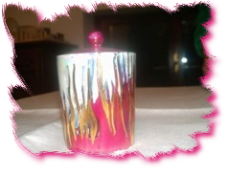
Mixed Techiques
It is the conjunction of two or more techniques.
Nearly all my pieces present almost two techniques; as well as the lustres, I like gold, but also playing with excavations and reliefs, setting glass pearls, melted before (in order to avoid they break during firing).
The box near here, that looks abstract, is the result of the combine of these themes.
Very modern an original, isn't it?
At least, I want to remind you the use of "broderie", a wonderful product that can be engraved by any point to obtain nice lace and, after fire, can also be plated by gold or platinum to have a splendid effect shiny-satined.
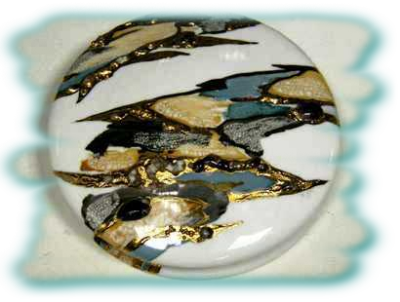
"Cuerda Seca"
Here the last technique I discovered. Also this one is a technique very long to realize and requires a good deal of patience and precision.
We work on a piece of biscuit of terracotta or porcelain. The colours actually are coloured glazes, that in kiln at very high temperatures (about 950░ - 980░ Celtius) melt, spreading on the plate and assuming very bright shadows, that contrast with the opacity of the baked clay.
The results are rather naif works, but also very lively. The first piece I venture on, just to stand by my tendency to begin soon by great and complex things, was an enormous tray with all sort of flowers, also in order to have a quite complete outlook of the range of colours. So iris, daisies, poppies, forget-me-nots, violets, cowslips, bellflowers, lies together in a riot of colours.
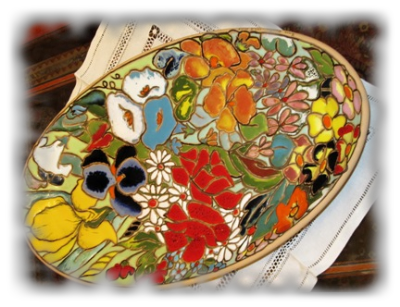
Under glaze painting
This technique, too, is rather long to realize, even if it doesn't take so much time than cuerda.
It is the way of painting that resumes the principles developped by the geatest renaissance masters in pottery.
You work on majolica or porcelain bisquits (that is on white paste). Colours are pigments soluble in water, so painting is clean and odourless. You can obtain all possible nuances, from the shades of watercolours to full colours. The intensity of a nuance - in fact - depends not only on which pigment you choose, but also, or mainly, on the intensity you use to put colours on the piece: more your colour is thined and more you obtain a clear shade, less the colour is thined and more the colour will be deep. It is necessary, therefore, to pay attention to avoid too much accumulation of painting, that might give unwlcome thickesses.
After paintin the piece will be glazed and fired over 900░ C.
The results are a very shining painting that will magnify medio-eval or renessaince patterns
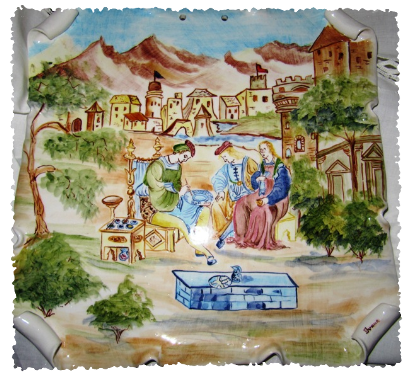
The Raku technique
The origins of this technique are very ancient and - in spite of the name - it seems that they have their roots at the Etruscan People.
In my opinion, this technique is a play, a summer day to enjoy in the open air (it is unconceivable in fact to think to carry on this technique in a flat). We have to use a semi-refractory material, because it is very tough and over all resistant to the hard thermic shocks it is subjected.
We decorate the object by enamels and metal oxides, more or less watered down, and we fire more than 900░ C. When the temperature is reached, we take immediately the object away (without waiting that the temperature will gradually slow down) and we throw it for some minutes in a mix of paper, sand and sawdust, smothering - by deduction of oxygen - the little flames that rise for spontaneous combustion. At the end, we temper the piece in cold water.
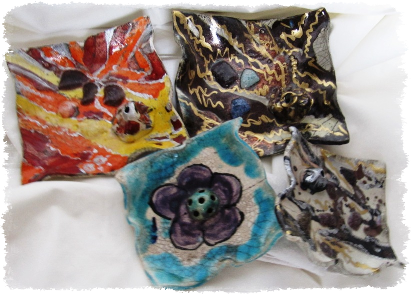
The results are always a surprise and a chance, because colours and nuances depend on the temperature and the time of each phases of this process. Where we haven't put colours the pieces becomes mat black, as a lavic stone.
I do not like so much this way to treat ceramic because it is impossible to forecast and to control the results; I have to recognize therefore that some metal effects are full of charm.
